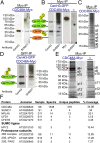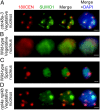The AAA-ATPase molecular chaperone Cdc48/p97 disassembles sumoylated centromeres, decondenses heterochromatin, and activates ribosomal RNA genes
- PMID: 25344531
- PMCID: PMC4234600
- DOI: 10.1073/pnas.1418564111
The AAA-ATPase molecular chaperone Cdc48/p97 disassembles sumoylated centromeres, decondenses heterochromatin, and activates ribosomal RNA genes
Abstract
Centromeres mediate chromosome segregation and are defined by the centromere-specific histone H3 variant (CenH3)/centromere protein A (CENP-A). Removal of CenH3 from centromeres is a general property of terminally differentiated cells, and the persistence of CenH3 increases the risk of diseases such as cancer. However, active mechanisms of centromere disassembly are unknown. Nondividing Arabidopsis pollen vegetative cells, which transport engulfed sperm by extended tip growth, undergo loss of CenH3; centromeric heterochromatin decondensation; and bulk activation of silent rRNA genes, accompanied by their translocation into the nucleolus. Here, we show that these processes are blocked by mutations in the evolutionarily conserved AAA-ATPase molecular chaperone, CDC48A, homologous to yeast Cdc48 and human p97 proteins, both of which are implicated in ubiquitin/small ubiquitin-like modifier (SUMO)-targeted protein degradation. We demonstrate that CDC48A physically associates with its heterodimeric cofactor UFD1-NPL4, known to bind ubiquitin and SUMO, as well as with SUMO1-modified CenH3 and mutations in NPL4 phenocopy cdc48a mutations. In WT vegetative cell nuclei, genetically unlinked ribosomal DNA (rDNA) loci are uniquely clustered together within the nucleolus and all major rRNA gene variants, including those rDNA variants silenced in leaves, are transcribed. In cdc48a mutant vegetative cell nuclei, however, these rDNA loci frequently colocalized with condensed centromeric heterochromatin at the external periphery of the nucleolus. Our results indicate that the CDC48A(NPL4) complex actively removes sumoylated CenH3 from centromeres and disrupts centromeric heterochromatin to release bulk rRNA genes into the nucleolus for ribosome production, which fuels single nucleus-driven pollen tube growth and is essential for plant reproduction.
Keywords: centromere disassembly; chromosome dynamics; heterochromatin decondensation; pollen tip growth; rDNA activation.
Conflict of interest statement
The authors declare no conflict of interest.
Figures





References
-
- Hennig W. Heterochromatin. Chromosoma. 1999;108(1):1–9. - PubMed
-
- Richards EJ, Elgin SC. Epigenetic codes for heterochromatin formation and silencing: Rounding up the usual suspects. Cell. 2002;108(4):489–500. - PubMed
-
- Jenuwein T, Allis CD. Translating the histone code. Science. 2001;293(5532):1074–1080. - PubMed
Publication types
MeSH terms
Substances
Grants and funding
LinkOut - more resources
Full Text Sources
Other Literature Sources
Molecular Biology Databases
Miscellaneous

